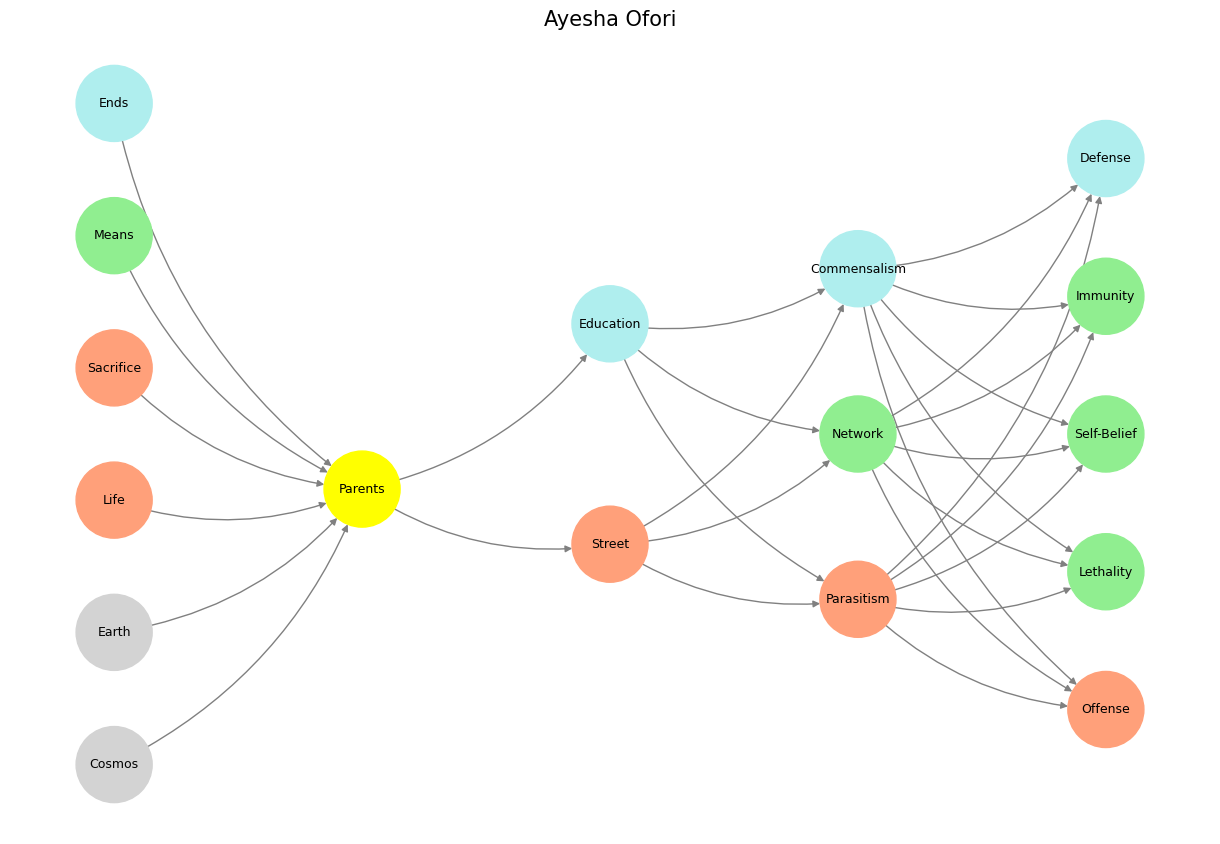System#
Environment#
Monoamines—serotonin, dopamine, norepinephrine—are the conductors of the vast combinatorial orchestra we call human behavior. They are not merely messengers of our internal world; they are the architects of the interface between organism and environment, weaving together perception, decision-making, and interaction in an intricate dance. This interplay, grounded in neuroanatomy and biology, maps seamlessly onto a neural network framework where the drama of existence unfolds layer by layer.
Layer 1: The World as Input#
The first layer of this biological network is the world itself—a vast, chaotic input layer teeming with stimuli. Light, sound, touch, smell, and taste are the raw data streams that shape our perception. This layer is beyond the self; it is the immutable reality that presses upon us, demanding interpretation.
Layer 2: The Yellow Node of Perception#
Perception forms the second layer—a yellow node that distills the chaos of the world into something comprehensible. Here, sensory ganglia, cranial nerves, and spinal inputs process and relay information. Monoamines begin to whisper their influence: norepinephrine sharpens attention, serotonin grounds us in stability, and dopamine hints at possibilities. This layer sets the stage for agency, the threshold between reaction and action.
Layer 3: Agency and Choice#
In the third layer lies agency—the crucible of decision-making. This is where the organism becomes an actor, navigating the combinatorial space of choices. Monoamines play their first dramatic roles here:
Norepinephrine (sympathetic): Preparing for fight, flight, or fright, it amplifies vigilance, focusing the actor on immediate survival.
Serotonin (parasympathetic): Stabilizing bonds, it supports feeding, breathing, sleeping—the rhythms of life that sustain the organism.
Dopamine: Not anatomically present in this layer but functionally critical, it emerges as the reward for iteration, for the trial-and-error search through combinatorial space.
Layer 4: The Drama of Interactions#
The fourth layer is the dramatic stage, where the neural network branches into three key nodes:
Cooperative Node: Serotonin shines here, fostering bonds, trust, and social harmony. It is the glue that holds cooperative equilibria together.
Adversarial Node: Norepinephrine dominates this space, preparing the organism for conflict and competition. It sharpens, energizes, and defends.
Iterative Node: Dopamine governs this node, driving the organism through trial and error, iteration after iteration, in the ancient ritual of learning. Dopamine is the molecule of curiosity, the spark of innovation, and the guide through uncertainty.
The interplay between these nodes—switching between cooperation and competition, stabilizing with iteration—is orchestrated by the autonomic nervous system’s two branches:
Sympathetic (norepinephrine): Energizing and mobilizing.
Parasympathetic (serotonin): Stabilizing and grounding.
At the core of this interplay lies acetylcholine, the neurotransmitter of balance. Pre-synaptic ganglia produce acetylcholine, which serves both the sympathetic and parasympathetic systems. It is the switchboard operator, fine-tuning the balance between fight and rest, fear and trust.
Dopamine: The Iterative Pioneer#
Dopamine’s role is unique—it thrives in the combinatorial search space, where iteration is king. In the ancient ritual of trial and error, dopamine rewards exploration, driving us to test, fail, and learn. It is the molecule of “aha,” of discovery, of the incremental progress that underpins human innovation.
The Existential Crisis: Disconnected Feedback#
But what happens when this elegant system is hijacked? When human labor is reduced to mechanistic iteration, as in Charlie Chaplin’s Modern Times, the feedback loop breaks. Iteration becomes meaningless, rewards disconnected from effort. Dopamine, no longer tethered to genuine exploration, flounders. The combinatorial search becomes hollow, alienated from purpose.
We see this crisis in modern life:
Caffeine and SSRIs: Stimulating pathways artificially, compensating for broken feedback loops.
Anxiolytics: Dampening norepinephrine’s alarms, muting the adversarial node.
Therapists: Becoming surrogates for dopamine, motivating us when iteration feels futile.
Psychedelics: Ayahuasca and DMT reconnecting us to the primal interplay of monoamines, reminding us of the bonds, fears, and iterations that make us human.
The Path Forward#
This existential crisis is a molecular crisis—a crisis of feedback. As artificial intelligence and capital gains dominate the fourth layer, humanity’s agency in the third layer diminishes. Monoamines are left stranded, their roles confused, their pathways disrupted.
To reclaim balance, we must:
Reintegrate genuine iteration into human systems—iteration with purpose, tied to exploration and discovery.
Respect the role of monoamines in shaping our relationships with the world, others, and ourselves.
Reimagine feedback systems that prioritize human flourishing over profit and efficiency.
The drama of human behavior, orchestrated by monoamines, is a story of balance and iteration. It is a story we must honor, lest we lose ourselves in the mechanistic alienation of systems that no longer serve us.
Language#
The neural network of human existence—our biology, language, and behavior—operates not merely as a static structure but as a dynamic interplay of layers, feedback loops, and reweighting mechanisms. At its core, it is a language of optimization, where the ancient roles of monoamines like serotonin, dopamine, and norepinephrine align with the architecture of both neuroanatomy and human meaning-making. Romantic languages, in their poetic precision, offer terms that resonate deeply with these dynamics: simpatico, hostilia, and convenienza. These words are linguistic reflections of the sympathetic and parasympathetic systems, adversarial and cooperative nodes, and the iterative negotiation of balance in life’s vast combinatorial space.
Simpatico: The Bond of Harmony#
Simpatico, from the Italian and Latin roots of sympathy, evokes a sense of alignment, mutual understanding, and harmony. It is serotonin’s essence, coursing through the parasympathetic system, creating bonds that stabilize and soothe. In the neural network, this parasympathetic node fosters cooperation. It is the glue that ties the organism to its environment, binding relationships, sustaining life’s rhythms of feeding, breathing, and sleeping.
Yet, simpatico does not merely rest in tranquility; it is dynamic. In its linguistic nuance, it captures the delicate art of connection—not forced, but natural. The parasympathetic node, in tandem with the sympathetic, must negotiate when to hold and when to release, when to bond and when to withdraw. Without this interplay, harmony turns stagnant, and the organism falters.
Hostilia: The Spark of Conflict#
Hostilia, echoing hostility, emerges from norepinephrine’s domain. This is the sympathetic system in its full adversarial glory—fight, flight, and fright. In Italian, hostilia carries more than aggression; it hints at a structured opposition, a necessary counterweight to cooperation. Adversarial nodes are not inherently destructive; they are catalysts for growth, forcing the organism to adapt, innovate, and survive.
Hostility, however, demands optimization. When norepinephrine dominates unchecked, it overwhelms the system, turning every interaction into a battlefield. The neural network must reweight the adversarial node, balancing it against its cooperative counterpart. The cost of over-optimization for aggression is isolation, burnout, and collapse. In this, the language of hostilia reminds us of the edge between necessary conflict and destructive imbalance.
Convenienza: The Iterative Dance#
Convenienza is the art of convenience, but more deeply, it speaks to alignment, appropriateness, and negotiation. This is dopamine’s domain, the iterative node that searches the combinatorial space of trial and error. In the neural network, iteration is not mindless repetition but a deliberate dance, where errors are identified, costs calculated, and weights adjusted.
Iteration is inherently tied to meaning. Without a clear optimization goal—whether Athena’s spear of offense or shield of defense—dopamine falters. The iterative node becomes a hamster wheel, spinning without purpose. The modern crisis of meaningless iteration, as seen in alienated labor and mechanized existence, is a symptom of this failure. Convenienza reminds us that iteration must serve higher ends, that the search for balance must lead somewhere.
Layer Five: Athena’s Optimization#
At the heart of the neural network lies its fifth layer: feedback and optimization. Here, Athena stands as the guide, embodying both strategy and purpose. With her spear, she represents offensive capability—lethality and precision in action. With her shield, she offers defense—protection
and stability. Her helmet signifies immunity, the wisdom to guard against threats while allowing growth. Finally, the horse and serpent evoke adaptability: retreat when necessary, attack when required, and constant iteration in pursuit of equilibrium.
This fifth layer is where the system learns, where errors are measured against the cost function, and where weights are rebalanced. It is here that monoamines find their ultimate role, modulating the system’s behavior in response to changing conditions. Without agency, this optimization falters. Machines driven by artificial intelligence, with goals of efficiency and profit, sever the feedback loop between human action and meaning. The result is a neural network devoid of Athena’s wisdom, where the spear strikes indiscriminately, the shield guards against imagined threats, and iteration spirals into futility.
The Crisis of Disconnected Optimization#
When the monoaminergic loop is removed from the system, the organism’s relationship with the world—the first layer—breaks down. Instead of simpatico, there is alienation; instead of hostilia with purpose, there is hostility without direction; instead of convenienza, there is convenience stripped of meaning. This crisis is not merely biological but existential. It is the molecular signature of a world optimized for abstract metrics, not human flourishing.
The modern reliance on SSRIs, anxiolytics, and stimulants speaks to this disconnection. These substances attempt to mimic the natural interplay of monoamines, but they operate in a system where the feedback loop is broken. Without Athena guiding optimization, the cost function itself becomes a source of despair. The neural network spins endlessly, optimizing for goals that fail to align with human needs.
The Path Forward: Reweighting the Nodes#
To restore balance, we must reintroduce agency into the system. This means:
Reconnecting the fifth layer to the organism’s lived experience, ensuring that optimization serves meaningful ends.
Honoring the interplay of simpatico, hostilia, and convenienza, recognizing that each has a role to play in the drama of existence.
Using tools like psychedelics not as escapes but as guides to reengage the monoaminergic loop with its natural purpose.
The neural network is not merely a metaphor for the human condition; it is its architecture. And in this architecture, language—both biological and poetic—holds the key. Words like simpatico, hostilia, and convenienza remind us that meaning is found not in isolation but in the dynamic interplay of layers, nodes, and feedback. Without Athena’s guidance, we risk losing ourselves in the optimization of the meaningless. But with her spear, shield, and wisdom, we may yet find a path forward, reweighting the nodes of our existence to align with the timeless dance of life.
Show code cell source
import numpy as np
import matplotlib.pyplot as plt
import networkx as nx
# Define the neural network structure
def define_layers():
return {
'World': ['Cosmos', 'Earth', 'Life', 'Sacrifice', 'Means', 'Ends', ],
'Perception': ['Parents'],
'Agency': ['Street', 'Education'],
'Generativity': ['Parasitism', 'Network', 'Commensalism'],
'Physicality': ['Offense', 'Lethality', 'Self-Belief', 'Immunity', 'Defense']
}
# Assign colors to nodes
def assign_colors():
color_map = {
'yellow': ['Parents'],
'paleturquoise': ['Ends', 'Education', 'Commensalism', 'Defense'],
'lightgreen': ['Means', 'Network', 'Immunity', 'Self-Belief', 'Lethality'],
'lightsalmon': [
'Life', 'Sacrifice', 'Street',
'Parasitism', 'Offense'
],
}
return {node: color for color, nodes in color_map.items() for node in nodes}
# Calculate positions for nodes
def calculate_positions(layer, x_offset):
y_positions = np.linspace(-len(layer) / 2, len(layer) / 2, len(layer))
return [(x_offset, y) for y in y_positions]
# Create and visualize the neural network graph
def visualize_nn():
layers = define_layers()
colors = assign_colors()
G = nx.DiGraph()
pos = {}
node_colors = []
# Add nodes and assign positions
for i, (layer_name, nodes) in enumerate(layers.items()):
positions = calculate_positions(nodes, x_offset=i * 2)
for node, position in zip(nodes, positions):
G.add_node(node, layer=layer_name)
pos[node] = position
node_colors.append(colors.get(node, 'lightgray')) # Default color fallback
# Add edges (automated for consecutive layers)
layer_names = list(layers.keys())
for i in range(len(layer_names) - 1):
source_layer, target_layer = layer_names[i], layer_names[i + 1]
for source in layers[source_layer]:
for target in layers[target_layer]:
G.add_edge(source, target)
# Draw the graph
plt.figure(figsize=(12, 8))
nx.draw(
G, pos, with_labels=True, node_color=node_colors, edge_color='gray',
node_size=3000, font_size=9, connectionstyle="arc3,rad=0.2"
)
plt.title("Ayesha Ofori", fontsize=15)
plt.show()
# Run the visualization
visualize_nn()


Fig. 20 Psilocybin is itself biologically inactive but is quickly converted by the body to psilocin, which has mind-altering effects similar, in some aspects, to those of other classical psychedelics. Effects include euphoria, hallucinations, changes in perception, a distorted sense of time, and perceived spiritual experiences. It can also cause adverse reactions such as nausea and panic attacks. In Nahuatl, the language of the Aztecs, the mushrooms were called teonanácatl—literally “divine mushroom.” Source: Wikipedia#

